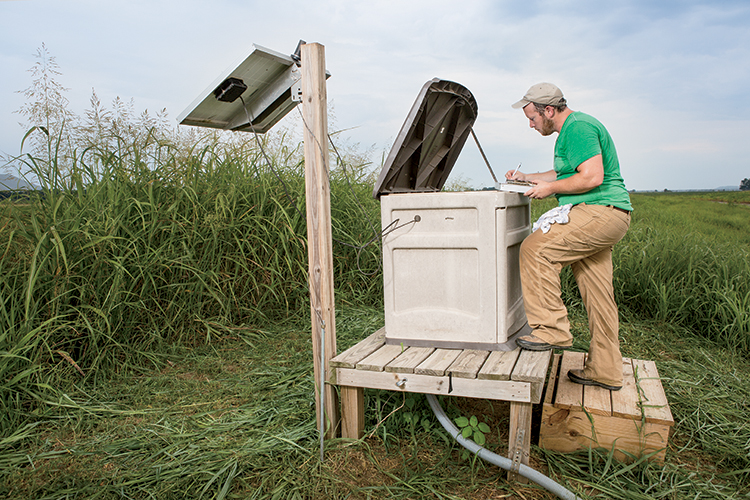Home > Arkansas > Arkansas Environment > Discover the Future of Conservation
Discover the Future of Conservation

In addition to being master scientists, business people and caretakers, farmers are also deeply concerned about the environment and are constantly innovating to improve conservation practices.
In Arkansas, a partnership between farmers, the University of Arkansas Division of Agriculture, and federal and state agencies through the Mississippi River Basin Healthy Watersheds Initiative, is conducting research to determine the effectiveness of water and soil conservation practices being implemented on working farms.

Collecting Data
This partnership, known as the Discovery Farm program, utilizes edge-of-field monitoring to help farmers verify the practices they have in place to minimize runoff nutrients from fertilizers are effective. This data is especially valuable as researchers seek to determine the causes of hypoxia, or dead zones, in the Gulf of Mexico. It is believed that hypoxia is caused by a number of factors, including excess nutrients that run off into the Mississippi River and are delivered into the Gulf.
“There isn’t a lot of substantial data, but a large-scale model has hypothesized that agriculture is the biggest contributor to this problem,” says Mike Daniels, professor of environmental management at the University of Arkansas. “But we really wanted some hard data — because farmers have always said if they were losing substantial nutrients, they would be seeing it in their yields. Farmers want to be as efficient as possible.”

Positive Projections
The Discovery Farm program began collecting data on farms in 2011, and Daniels says that data, while still incomplete, seems to confirm that farmers are doing a good job at minimizing nutrient loss.
“So far, the numbers we find on the edges of these fields are usually pretty low,” Daniels says. “We’re ready to say we’re being efficient with our nutrients and doing a good job managing them in row crop and livestock situations. Farmers are losing less than 10 percent of what they’re applying, which means there’s not a lot of room for improvement in some cases. It looks pretty positive. But we haven’t been monitoring long enough to really say for sure.”
Other sources of fertilizer runoff may include golf courses, sports fields and municipalities or homeowners who fertilize their grass. Daniels says farmers are taking the lead in seeking best practices for their farms.
“What this program boils down to is farmers taking ownership of this,” Daniels says. “The best solutions we can have come from farmers who are motivated to make change.”

Win-Win For Everyone
Johnny Maus, who owns an 80-acre farm in the Atkins River Bottoms area, participates in the Discovery Farm program along with nine other farmers across the state.
As a farmer, Maus says he looks forward to having hard data that proves he and other farmers are good stewards of the land. And Maus says if his farm has any issues with nutrient runoff, he wants to know about it and develop solutions.
“The vast majority of farmers are extremely good stewards of the land,” Maus says. “Farmers want to do right and care for the environment, and farmers have a vested interest to make sure their practices are safe and effective — they want the land to stay healthy for generations to come, and financially, nobody wants to put fertilizer out and see it run off in ditches and rivers.”
Robert “Crash” Carruthers, owner and operator of Pecan Arkansas in Morrilton and an Arkansas Agriculture Board member, has been involved with Discovery Farms from the start. He says it would be ideal to have about 50 more Discovery Farms along the Mississippi River, but getting farmers to participate has been challenging because some fear criticism from the government or others.
“But there’s no reason to be scared of this,” Carruthers says. “It’s all positive. They have found in most locations so far that there’s significantly less nutrient loss than they had anticipated, and if they did find any issues, they’d help come up with a plan and practices to fix them. In addition, it’s really cost effective because you don’t have to spend any more money to become more efficient.”



